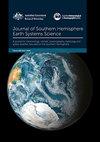Seasonal climate summary for the southern hemisphere (spring 2016): strong negative Indian Ocean Dipole ends, bringing second wettest September to Australia
IF 3.6
4区 地球科学
Q1 Earth and Planetary Sciences
引用次数: 2
Abstract
This summary looks at the southern hemisphere and equatorial climate patterns for spring 2016, with particular attention given to the Australasian and equatorial regions of the Pacific and Indian Ocean basins. Spring 2016 was marked by the later part of a strong negative phase of the Indian Ocean Dipole, alongside cool neutral El Niño–Southern Oscillation conditions. September was exceptionally wet over much of Australia, contributing to a wet spring with near-average temperatures. The spring was one of the warmest on record over the southern hemisphere as a whole, with Antarctic Sea ice extent dropping to record low levels for the season.南半球季节气候总结(2016年春季):印度洋强负偶极子结束,给澳大利亚带来第二潮湿的9月
本摘要着眼于2016年春季南半球和赤道气候模式,特别关注太平洋和印度洋盆地的大洋洲和赤道地区。2016年春季的特点是印度洋偶极子强负相位的后期,同时伴有凉爽的中性厄尔尼诺Niño-Southern振荡条件。9月,澳大利亚大部分地区异常潮湿,导致春季潮湿,气温接近平均水平。今年春天是南半球有史以来最温暖的春天之一,南极海冰范围降至创纪录的最低水平。
本文章由计算机程序翻译,如有差异,请以英文原文为准。
求助全文
约1分钟内获得全文
求助全文
来源期刊

Journal of Southern Hemisphere Earth Systems Science
Earth and Planetary Sciences-Oceanography
CiteScore
8.10
自引率
8.30%
发文量
0
审稿时长
>12 weeks
期刊介绍:
The Journal of Southern Hemisphere Earth Systems Science (JSHESS) publishes broad areas of research with a distinct emphasis on the Southern Hemisphere. The scope of the Journal encompasses the study of the mean state, variability and change of the atmosphere, oceans, and land surface, including the cryosphere, from hemispheric to regional scales.
general circulation of the atmosphere and oceans,
climate change and variability ,
climate impacts,
climate modelling ,
past change in the climate system including palaeoclimate variability,
atmospheric dynamics,
synoptic meteorology,
mesoscale meteorology and severe weather,
tropical meteorology,
observation systems,
remote sensing of atmospheric, oceanic and land surface processes,
weather, climate and ocean prediction,
atmospheric and oceanic composition and chemistry,
physical oceanography,
air‐sea interactions,
coastal zone processes,
hydrology,
cryosphere‐atmosphere interactions,
land surface‐atmosphere interactions,
space weather, including impacts and mitigation on technology,
ionospheric, magnetospheric, auroral and space physics,
data assimilation applied to the above subject areas .
Authors are encouraged to contact the Editor for specific advice on whether the subject matter of a proposed submission is appropriate for the Journal of Southern Hemisphere Earth Systems Science.
 求助内容:
求助内容: 应助结果提醒方式:
应助结果提醒方式:


